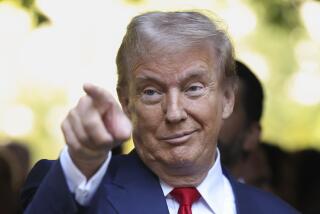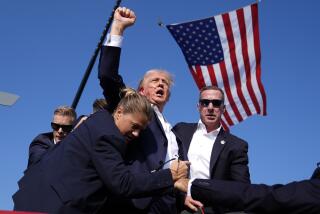Editorial: China sees right through Trump’s posturing

President Trump is pushing his trade dispute with China to new rhetorical heights. If the plan is to persuade China to back down before a trade war breaks out, however, it doesn’t appear to be working.
After Trump rolled out plans to levy tariffs on imported goods — first on steel and aluminum, then on about 1,300 other types of products from China — the Chinese government responded in kind, announcing its intention to slap tariffs on products imported from the U.S. The responses from China were both predictable and proportional, threatening $1 in U.S. exports for every $1 in Chinese exports targeted by Trump.
For Trump, however, they were an excuse to escalate the dispute. Late Thursday afternoon, he announced that his administration was now considering tariffs on an additional $100 billion worth of Chinese goods, which would triple the amount of Chinese exports being targeted. “Rather than remedy its misconduct, China has chosen to harm our farmers and manufacturers,” Trump said in a statement — as if Chinese President Xi Jinping should have simply crumpled in the face of Trump’s previous escalation.
Whether Trump likes it or not, however, this particular drama is playing out more like “Dancing With the Stars” than “The Apprentice.” The Chinese president seems committed to matching Trump step for step as the two countries circle to the beat of a trade war. According to the Wall Street Journal, a Chinese government spokesman said in response to Trump’s latest move, “The Chinese side will follow suit to the end, not hesitate to pay any price, resolutely counterattack and take new comprehensive measures in response.”
The exchanges are nothing more than posturing at this point. Neither country has actually levied any new tariffs or imposed any new quotas yet — those are still months away. The impact of the threats and counterthreats has been limited to the gyrations they’ve caused in the stock market (the Dow Jones industrial average has dropped more than it has climbed, surrendering all of its gains from earlier this year) and the anxiety they’ve sowed among trade-dependent U.S. manufacturers, farmers and retailers.
A president who relies on threats as a negotiating tactic has to follow through on them at some point. Otherwise they have no credibility.
Trump obviously feels that stepping on those particular toes is necessary to winning this particular contest. To him, the fact that China ships about $30 billion worth of products more into the U.S. than it buys is a sign that the playing field is tilted, with jobs and other benefits flowing toward Beijing.
It’s simplistic, however, to interpret the U.S. trade deficit as a mere scorecard, with the negative trade balance signifying that the U.S. is losing. The deficit reflects not just the effect of U.S. and Chinese trade policies, but also Americans’ inexhaustible demand for goods, peerless buying power and nervy determination to spend rather than save. In fact, policies championed by Trump — big tax cuts and low interest rates — reinforce those uniquely American traits and will likely widen the trade deficit.
And let’s face it, low-cost imports benefit consumers and the industries that serve them. That’s the other side of the tariff coin; any penalties placed on Chinese exports will be paid by Americans, in the form of higher prices. In other words, tariffs are like another version of a sales tax.
Trump is right about this: There is a human cost to the flood of cheap imports, and it’s reflected in the loss of manufacturing jobs as companies shift production outside the U.S. or automate to stay competitive. And he is right about China not competing fairly. Its state-owned industries employ too many workers and overproduce goods, then export them at subsidized prices, because that serves the political imperatives of the Chinese government, not the demands of the global market. The country also has engaged in a maddening series of illegal tactics that harm U.S. exporters and investors, despite pledging to abide by World Trade Organization norms.
Part of the challenge for policymakers has nothing to do with China. Instead, it’s how to improve the way U.S. schools, colleges and job-training programs equip works for higher-skill, higher-wage jobs that can withstand cheap foreign competition. But part of the challenge comes down to trade policy — specifically, how to stop China’s trade cheating.
Trump is betting that he can tee up so much harm to Chinese exports that China will come to the negotiating table chastened and eager for a deal. After all, he got South Korea to renegotiate a bilateral free-trade agreement by saying the U.S. might withdraw from it, winning some concessions on steel exports and currency manipulation. But South Korea is an ally; China is a far less friendly trading partner with an economy that’s almost an order of magnitude larger than Korea’s. By late Friday, the Chinese government was saying it wouldn’t even negotiate with the U.S. as long as Trump was upping the ante on tariffs.
A president who relies on threats as a negotiating tactic has to follow through on them at some point. Otherwise they have no credibility. And China appears perfectly willing to call Trump’s bluff and let a real trade war begin. After all, it has many other outlets for its goods, and its state-owned industries are far more tolerant of disruption than U.S. farmers and publicly traded companies are.
That’s why Trump should have taken a different approach from the start, working with other trading partners to bring broad sanctions against China that would be hard to circumvent and carry real consequences for Xi. In a statement Friday morning, the administration said it is exploring that path too, bringing a complaint about China to the World Trade Organization and “working with allies also affected by China’s unfair behavior to restore fairness to global trade.” Such efforts hold more promise than Trump’s ever escalating tariff threats.
Follow the Opinion section on Twitter @latimesopinionand Facebook
More to Read
A cure for the common opinion
Get thought-provoking perspectives with our weekly newsletter.
You may occasionally receive promotional content from the Los Angeles Times.










